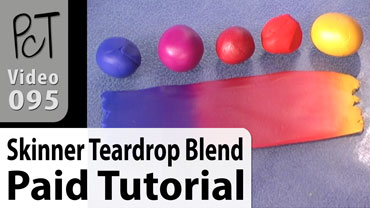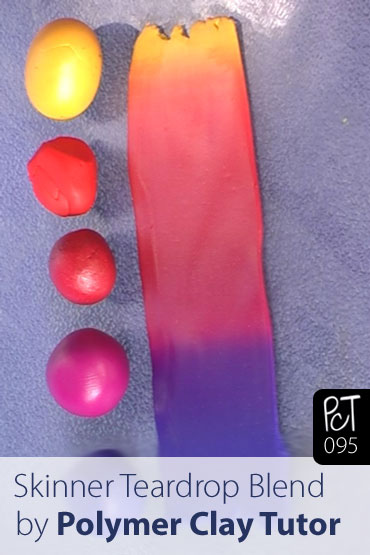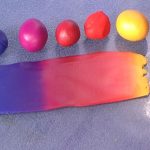Vol-009-3 Tear Drop Method Quick Skinner Blend PcT (Intro)
Video #095: Get Smooth Polymer Clay Color Gradients 10 Times Faster Than Using The Traditional Triangles Approach.
More...
** This post is an introduction to one of our paid tutorials.
If the normal Skinner Blend method of rolling, cutting and placing flat triangles of clay seems tedious to you (or difficult to understand)… then you are going to love my tear drop approach to making beautiful and smooth polymer clay color gradients.
Now don’t get me wrong, I think Judith Skinner is a true Polymer Clay Hero. She came up with a clay color blending technique (The Skinner Blend) that vastly improved upon the original Stepped Method for mixing and blending polymer clay colors.
Before Judith came along, polymer clay artists used this Stepped Method to laboriously measure and mix clay colors, more like a cooking recipe. For example, to make a blended color sheet that went from white to blue, you would mix separate color batches starting with 1 part blue + 5 parts white; Then 2 parts blue + 4 parts white; Then 3 parts blue + 3 parts white; And so on until you had six shades of blue from light to dark.
Then these shades were stacked to get a gradated blend. The more shades you made, the smoother the blend appeared. But it was always ‘stepped’ and never perfect. And as you can imagine, it was a ton of work!
Then Judith showed up and used her scientific brain to devise a much easier and faster method.
She cut out 2 matching flat triangle pieces using 2 different colors…
Flipped one of the triangles so that its diagonal could be butted up against the other one to form a rectangle…
Did an end to end fold over of the rectangle and passed it through a pasta machine.
After more folding and multiple passes through the pasta machine, she ended up with a seamless color blended sheet…without all the hassle of individually measuring and mixing each shade variation. Much better!
A process of steps like that seems like it should have taken some time for Judith Skinner to think up. But I read something about her once where she said it actually just came to her quickly. The background she had with math and science gave her a logical approach to the problem, and she went with it.
Well that is kind of what happened to me… though in a far less scientific manner and in more of a winging it kind of way.
I hate to measure. Oh, I’ll do it if I have to. But if I can get away with eyeballing something, I will. So the process of… rolling sheets of clay… cutting them into triangles… flipping and repositioning to make multicolored rectangles… folding… blending… well, it all seems a bit fussy to me.
And then it dawned on me one day when I was making some teardrop shapes of clay. You know the ball of clay that you can shape into a point at one end by rolling it in your palms to form a V-shape? Yeah… that teardrop.
Anyway, two colors of clay teardrops were laying side by side in opposite directions, and it struck me that they were triangles! If I just squashed them together, they would basically end up achieving the same effect as what happens with a Skinner Blend. Cool!
Then with some more fooling around, I figured out how to roll the blend instead of folding it so that it would blend almost ten times faster!
This meant instead of taking ten minutes to make a blend from start to finish, I could do one in under a minute! Very Cool!
Now I could even do tiny little test blends to see if I liked it before committing to a large batch, since this technique is very quick and easy to do, even with very tiny amounts of clay.
And… doing multicolored blends with a whole rainbow of colors is a snap with this technique! No more figuring out exactly how to cut the right shapes so that they will fit together. No more measuring, cutting or fussing around. Easy and fast. Now that’s my kind of Skinner Blend!
For lack of a better name, I’ve coined this modified Skinner Blend technique as the Tear Drop Method. I made a full tutorial video that is posted in Volume-009 at the Members Library.
ADDENDUM: Unfortunately, this Vol-009-3 tutorial is no longer available for purchase. However, the button below, will take you to our Polymer Clay Tutor Store, where there is a wide variety of other premium tutorials that you can choose from...
Shareable Images




Want to chat about today’s post? That’s what the comment section below is for. Scroll Down… We’d love to hear from you!
Or... if you would like to request a topic for a future post, here is the link to do that… PcT Suggestion Box


Just came upon this site and saw your innovative method for the skinner blend. I can’t wait to try it out! Thanks for the tutorial.
Thank you for your kind words Nancy! Make sure to take a good look around the site and to use the search box. There is tons and tons of info that will help you answer any polymer clay questions you may have. Thanks for commenting!
Great and easy technique. It is faster and successful also. The video is very self explanatory. I too was not sure about the width. But I watched your video two to three times and then got it right.
Thanks so much for sharing this technique. Not only is it faster, it is far easier to get successful blends without all the trial. Your technique of rolling the log with the acrylic roller then rolling the log from the bottom is the secret to speeding up the blend. This is exciting.
Your quick skinner blend video was what I was looking for. You’re so clever! I’m a big efficiency nut, so this is great! Bravo.=
today working on johhny jump ups and its amazing how a person can work from past issues to the current. Im trying to think of all of your training youve done to do these series. surely you have taken speech and production etc etc. to glorouously make your own business. Cudos to you Cindy. Im fascinated by what you do and to also get your family involved. Thanks so much for this uplifting lesson. Sorry so chatty.
Wait, Dizi’s comment is just like Cherie’s above…what? And Cindy answered her. Hmmm…
Anyway, I realize the question’s more about the width of the blend, not so much the thickness of the sheet. In Cindy’s latest tute, the Sculpted Iris Flower Beads video, she demonstrates how to take a wide blend and make it thinner (as part of her project.) Perfect timing…watch it & you’ll understand perfectly! ~Kat
PS: If you’re not a member (why not? LOL) use the search box for more info. Try “wide blend” or similar, and you’ll find a post Cindy wrote with tips on how to keep your blends from getting too wide…
I’ve tried the tear drop blend a few times now and done a few pieces with them. I have a question ; in the video Cindy runs it through on the thickest setting always. Can you run it on thinner settings to lengthen the piece of clay and prevent it from getting too wide? I have followed Cindy’s tip about putting your thumb and finger and gently squeezing to keep it from stretching. Just thought , would it work going to a thinner setting? yes thankss
@Dizi: You can run it through thinner settings, but it’s a good idea to do it setting-by-setting (or at least every OTHER setting.) Taking a thick piece of clay and immediately running it through a thin setting could stress your pasta machine (bending scraper blades, etc.) Better to be safe, and use a thicker setting first, then take it down in increments…using the finger trick with each pass. For example, with a 7-setting PM, take your softened clay & run it thru setting # 6 (the 2nd thickest,) then #4, then #2, etc. — until it’s as thin as you need.
(IMO, Cindy uses the thickest setting because that’s what’s required for that project. I’ve seen her go straight to thin in one of her videos…although she warns us not to do that in the video. She said the reason she was able to do it was because her clay was already so warm from the lights they use for filming…)